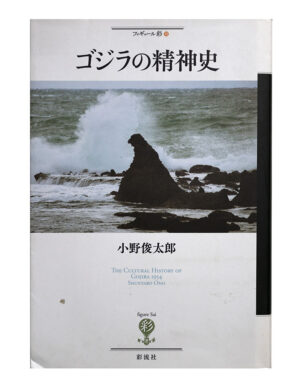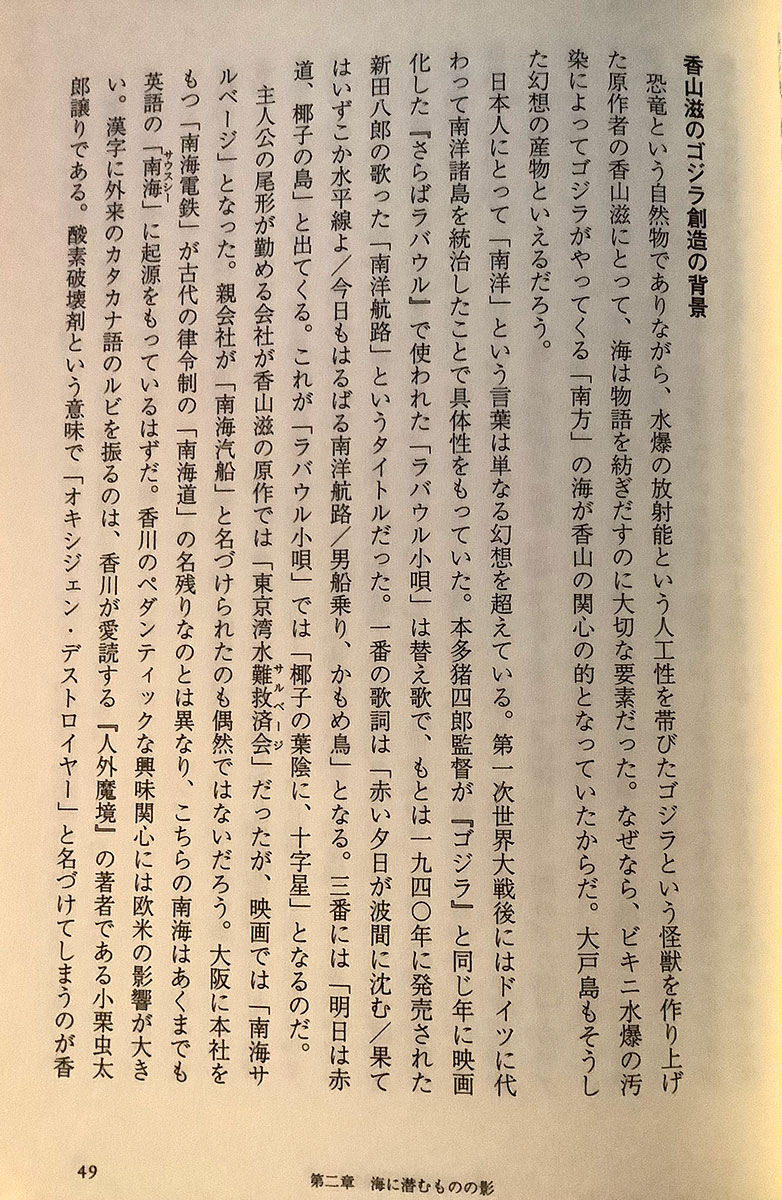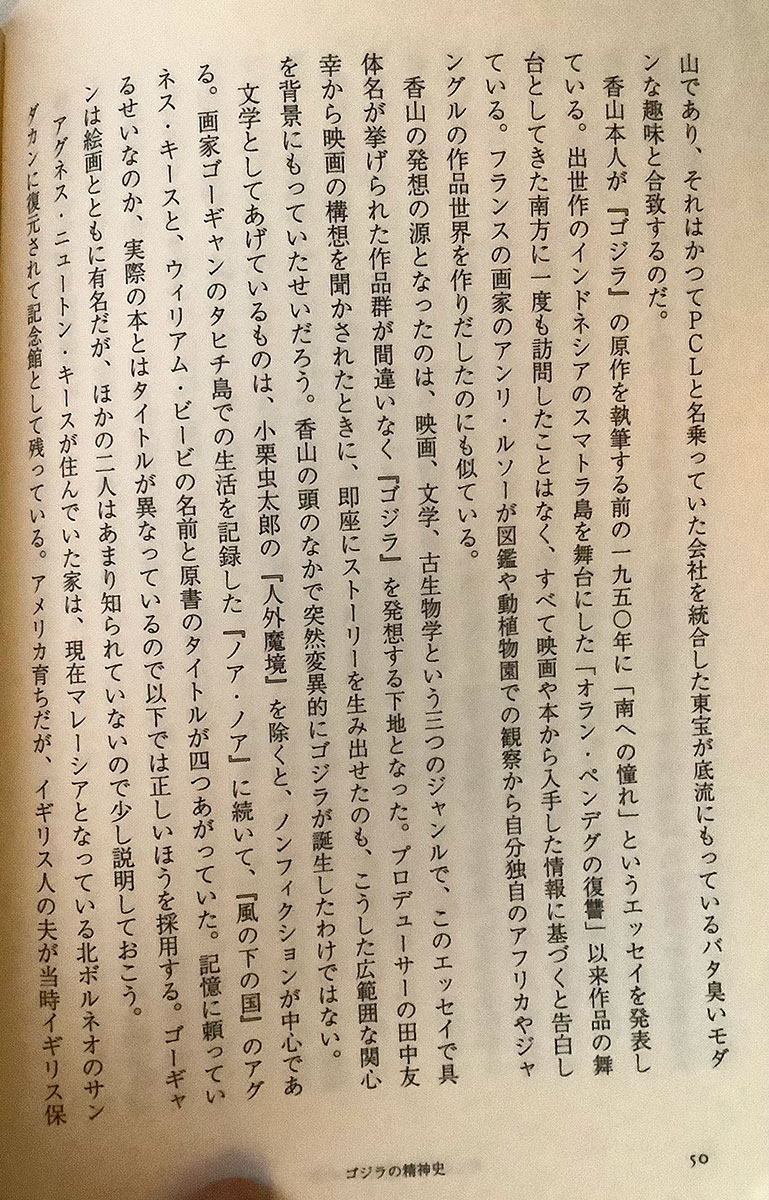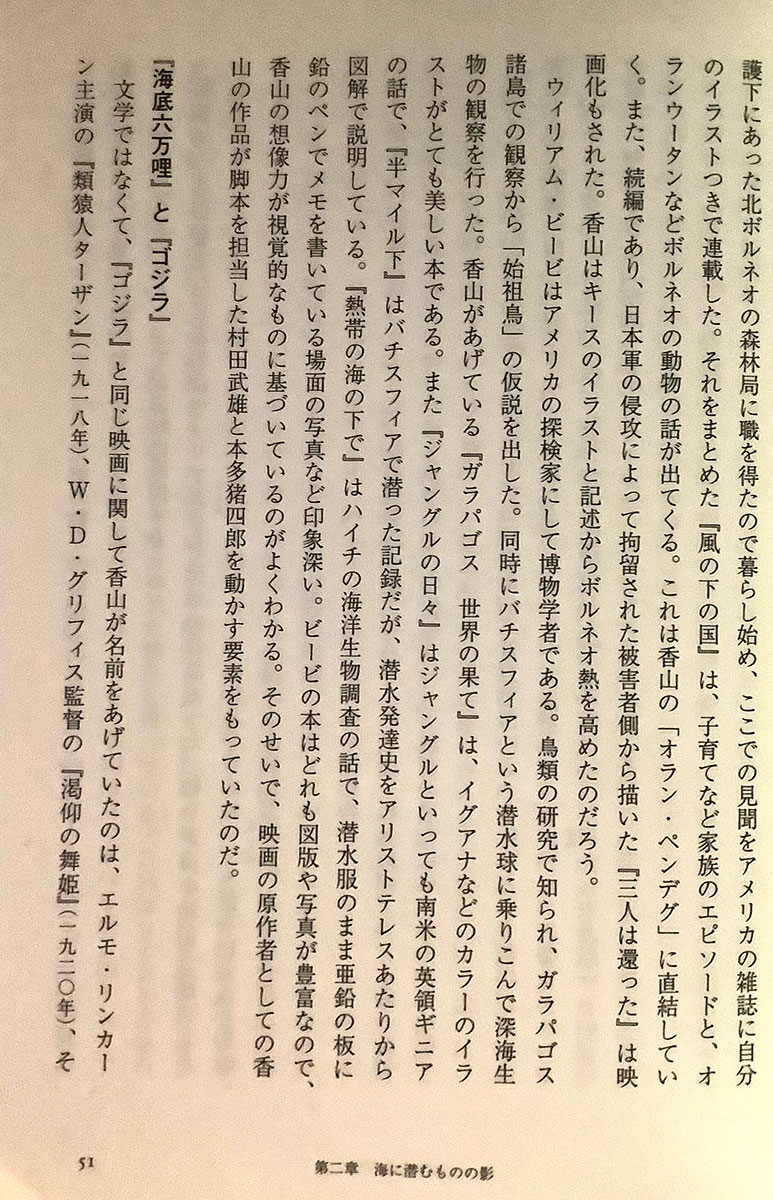11.17.2022
The Cultural History of Godzilla – Pt 21


P 49
香山滋のゴジラ創造の背景
Background of Shigeru Kayama’s creation of Godzilla
恐竜という自然物でありながら、水爆の放射能という人工性を帯びたゴジラという怪獣を作り上げ原作者の香山滋にとって、海は物語を紡ぎだすのに大切な要素だった。なぜなら、ビキニ水爆の汚染によってゴジラがやってくる「南方」の海が香山の関心の的となっていたからだ。大戸島もそうし幻想の産物といえるだろう。
For Shigeru Kayama, the original author who created a monster called Godzilla, which is a natural creature like a dinosaur, but is tinged with the artificial radiation of a hydrogen bomb, the sea was an important element in spinning out the story. This is because the “southern” sea where Godzilla is coming due to the contamination of the Bikini Hydrogen bomb has become the focus of Kayama’s interest. Odo Island can also be said to be a product of fantasy.
日本人にとって「南洋」という言葉は単なる幻想を超えている。第一次世界大戦後にはドイツに代 わって南洋諸島を統治したことで具体性をもっていた。本多猪四郎監督が「ゴジラ』と同じ年に映画化した「さらばラバウル』で使われた「ラバウル小唄」は替え歌で、もとは一九四〇年に発売された 新田八郎の歌った「南洋航路」というタイトルだった。一番の歌詞は「赤い夕日が波間に沈む/果て はいずこか水平線/今日もはるばる南洋航路/男船乗り、かもめ鳥」となる。三番には「明日は赤 道、椰子の島」と出てくる。これが「ラバウル小唄」では「椰子の葉陰に、十字星」となるのだ。
For the Japanese, the term “South Seas” is more than just an illusion. After the First World War, Japan took the place of Germany and ruled the South Sea Islands. “Rabaul Kouta” used in “Farewell Rabaul,” which was made into a movie by Ishiro Honda in the same year as “Godzilla,” was originally sung by Hachiro Nitta, released in 1940. It was titled “South Sea Route.” The first lyric is “The red sunset sinks into the waves/The horizon is somewhere in the end/Today’s all the way to the South Seas/Man sailor, gull bird.” In number three, it says, “Tomorrow is the equator, a palm island.” In “Rabaul Kouta,” this becomes “In the shadow of a palm leaf, a cross star.”
サルベージ 主人公の尾形が勤める会社が香山滋の原作では「東京湾水難救済会」だったが、映画では「南海サルベージ」となった。親会社が「南海汽船」と名づけられたのも偶然ではないだろう。大阪に本社をもつ「南海電鉄」が古代の律令制の「南海道」の名残りなのとは異なり、こちらの南海はあくまでもサウスシー 英語の「南海」に起源をもっているはずだ。香川のペダンティックな興味関心には欧米の影響が大き い。漢字に外来のカタカナ語のルビを振るのは、香川が愛読する「人外魔境」の著者である小栗虫太 郎譲りである。酸素破壊剤という意味で「オキシジェン・デストロイヤー」と名づけてしまうのが香山であり、それはかつてPCLと名乗っていた会社を統合した東宝が底流にもっているバタ臭いモダンな趣味と合致するのだ。
Salvage In Shigeru Kayama’s original work, the company where the main character, Ogata, works was called “Tokyo Wan Relief Society,” but in the movie it became “Nankai Salvage.” It is no coincidence that the parent company was named Nankai Kisen. Unlike the Nankai Electric Railway, which has its head office in Osaka, is a remnant of the ancient Ritsuryo system’s Nankaido, this Nankai must have its origins in South Sea’s English name, Nankai. Kagawa’s pedantic interests are greatly influenced by Europe and the United States. The use of foreign katakana ruby for the kanji was inherited from Mushitaro Oguri, the author of Kagawa’s favorite book, Jingai Makyo. It is Kayama who calls it “Oxygen Destroyer” in the sense of an oxygen destroying agent, and it matches the wild modern taste that Toho, which merged with the company that was once called PCL, has an undercurrent.

P 50
香山本人が「ゴジラ」の原作を執筆する前の一九五〇年に「南への憧れ」というエッセイを発表している。出世作のインドネシアのスマトラ島を舞台にした「オラン・ペンデグの復讐」以来作品の舞 台としてきた南方に一度も訪問したことはなく、すべて映画や本から入手した情報に基づくと告白している。フランスの画家のアンリ・ルソーが図鑑や動植物園での観察から自分独自のアフリカやジャ ングルの作品世界を作りだしたのにも似ている。
In 1950, before Kayama himself wrote the original work of “Godzilla,” he published an essay called “Southern Admiration.” He has never been to the south where he has set his works since “Revenge of Orang Pendeg,” which is set in Sumatra, Indonesia, which is the stage of his career, and he has based everything on information obtained from movies and books. It is similar to how the French painter Henri Rousseau created his own world of Africa and his Nguru works from his illustrated reference books and his observations at the zoo and botanical gardens.
香山の発想の源となったのは、映画、文学、古生物学という三つのジャンルで、このエッセイで具 体名が挙げられた作品群が間違いなく「ゴジラ」を発想する下地となった。プロデューサーの田中友幸から映画の構想を聞かされたときに、即座にストーリーを生み出せたのも、こうした広範囲な関心を背景にもっていたせいだろう。香山の頭のなかで突然変異的にゴジラが誕生したわけではない。
The sources of Kayama’s ideas were the three genres of film, literature, and paleontology. This wide-ranging interest is probably the reason why he was able to create a story immediately when he was told about the concept of the film by producer Tomoyuki Tanaka. Godzilla was not born by mutation in Kayama’s head.
文学としてあげているものは、小栗虫太郎の「人外魔境」を除くと、ノンフィクションが中心である。画家ゴーギャンのタヒチ島での生活を記録した『ノア・ノア』に続いて、「風の下の国』のアグネス・キースと、ウィリアム・ビービの名前と原書のタイトルが四つあがっていた。記憶に頼っているせいなのか、実際の本とはタイトルが異なっているので以下では正しいほうを採用する。ゴーギャ ンは絵画とともに有名だが、ほかの二人はあまり知られていないので少し説明しておこう。
Except for Mushitaro Oguri’s “Human Gaitamakyo,” the literature I list is mainly non-fiction. Following “Noah Noah,” which records the life of the painter Gauguin on the island of Tahiti, Agnes Keith of “The Land Under the Wind” and William Beebe’s name and the title of the original book were four. Gauguin is famous for his paintings, but the other two are not well known, so I will explain a little.
アグネス・ニュートン・キースが住んでいた家は、現在マレーシアとなっている北ボルネオのサンダカンに復元されて記念館として残っている。アメリカ育ちだが、イギリス人の夫が当時イギリス保護下にあった北ボルネオの森林局に職を得たので暮らし始め、ここでの見聞をアメリカの雑誌に自分のイラストつきで連載した。
The house where Agnes Newton Keith lived has been restored as a memorial in Sandakan, North Borneo, which is now Malaysia. She was raised in the United States, but her British husband got a job with the Forest Service in North Borneo, then under British protection, so she began living there, and she wrote about her experiences here in an American magazine, serialized with illustrations.
Agnes Newton Keith was an American writer best known for her three autobiographical accounts of life in North Borneo before, during, and after World War II. (Source: Wikipedia)

P 51
それをまとめた『風の下の国』は、子育てなど家族のエピソードと、オランウータンなどボルネオの動物の話が出てくる。 これは香山の「オラン・ペンデグ」に直結していく。また、続編であり、日本軍の侵攻によって拘留された被害者側から描いた「三人は還った』は映 画化もされた。香山はキースのイラストと記述からボルネオ熱を高めたのだろう。
In “Natural History Publications,” which is a compilation of these stories, there are family episodes such as raising children, as well as stories about Borneo’s animals such as orangutans. This is directly connected to Kayama’s “Orang Pendeg.” In addition, the sequel, “Three people have returned,” which was drawn from the side of the victims who were detained by the invasion of the Japanese army, was also made into a movie.
ウィリアム・ビービはアメリカの探検家にして博物学者である。鳥類の研究で知られ、ガラパゴス諸島での観察から「始祖鳥」の仮説を出した。同時にバチスフィアという潜水球に乗りこんで深海生 物の観察を行った。香山があげている「ガラパゴス世界の果て」は、イグアナなどのカラーのイラストがとても美しい本である。また「ジャングルの日々」はジャングルといっても南米の英領ギニアの話で、『半マイルド』はバチスフィアで潜った記録だが、潜水発達史をアリストテレスあたりから図解で説明している。『熱帯の海の下で」はハイチの海洋生物調査の話で、潜水服のまま亜鉛の板に鉛のペンでメモを書いている場面の写真など印象深い。ビービの本はどれも図版や写真が豊富なので、香山の想像力が視覚的なものに基づいているのがよくわかる。そのせいで、映画の原作者としての香山の作品が脚本を担当した村田武雄と本多猪四郎を動かす要素をもっていたのだ。
William Beebe was an American explorer and naturalist. Known for his studies of birds, he hypothesized the “Archaeopteryx” from his observations in the Galapagos Islands. At the same time, he boarded a diving ball called Bathysphere to observe deep-sea creatures. Kayama’s “End of the Galapagos World” is a book with beautiful color illustrations of iguanas and other animals. Also, “Days of the Jungle” is a story about British Guinea in South America, and “Half Mild” is a record of diving in Bathysphere, but it explains the history of diving development with illustrations from around Aristotle. “Under the Tropical Sea” is a story about a survey of marine life in Haiti, and the photograph of a scene in which he writes notes with a lead pen on a zinc plate while still in a diving suit leaves a strong impression. All of Beebe’s books are rich in illustrations and photographs, so it’s easy to see that Kayama’s imagination is based on the visual. Because of that, Kayama’s work as the original author of the movie had elements that moved Takeo Murata and Ishiro Honda, who were in charge of the screenplay.
…